
As a reporter, I sometimes get stuck on story ideas – and I had really wanted to write about healing crystals and roller derby. (Not for the same article, though that would have been cool.)
Instead, those two prospective pieces now live in a folder full of my non-starters – ideas I pitched passionately, but could never pull together. And all for the same reason: None of the business owners, publicists, experts or industry insiders I reached out to replied when I emailed them for comments.
Updating the editorial team on my (lack of) progress started out as a sheepish endeavor. My status reports quickly morphed into commiseration sessions, though, in which we’d all bemoan our respective inabilities to connect via email with professional contacts on everything from scheduling meetings to answering simple questions.
Was it something we said?
Intrigued by our shared experience, I put out a request to women business owners and leaders via Help a Reporter Out, an online service for journalists seeking sources. What I wanted to know was: Were others having the same email-related problems? Within a day, I had received dozens of frustration-laden replies through the website that collectively said: “YES.”
“Even five years ago, most of my emails to business partners were answered within an hour,” Alexandra Dubakova, CMO of online travel company Freetour.com, told me. “Now, it seems like my colleagues have adopted the habit of checking their mailboxes only once a day.” Getting responses that are clear and complete is also increasingly tricky, she continued.
In all, I read almost 100 answers to my inquiry that echoed her sentiments. So, what gives?
Where Is Everybody?
For starters, we’re not in Kansas anymore when it comes to email, Dorothy. The first electronic message was sent in 1965, though email didn’t achieve social omnipresence until decades later, in the late 1990s – thanks to a boom in home computer ownership, the launch of hosting sites like AOL, Hotmail and Yahoo! Mail, and the release of the oft-revered (if mildly controversial) rom-com classic, “You’ve Got Mail.”
Email continued to spread and evolve in the years following that first explosion, growing increasingly integrated into our everyday lives as smartphones made it easier, still, to check one’s inbox. Today, an email address is a standard asset for the vast majority of people, even Gen Zers. Gmail, currently the world’s most popular email provider, reports over 1.8 billion active accounts as of 2023.
That said, email doesn’t enjoy the status it used to as our preferred mode of communication. Rather, it’s increasingly regarded as inefficient and antiquated, especially among members of younger generations who are eschewing email use, both professionally and personally, in favor of social media direct messages and texting services like WhatsApp.
But the emails themselves haven’t slowed down in tandem with this societal shift. In fact, we’re actually dealing with more messages now than ever before. Last year, a whopping 347.3 billion emails went out into the world. And one study estimates that 56.5% of incoming emails are spam – roughly 194.5 billion junk emails last year alone.
The result? A massive pile-up. People have an average of 276 unopened emails in their inboxes at any given moment, one study finds. (More informally, I asked my Facebook contacts to share the number of unread messages in their inboxes – and many confessed to thousands, even tens of thousands.)
Email, it seems, has snowballed out of our collective control.
And managing the over-saturation weighs on us, particularly computer-based workers. Researchers at the University of California, Irvine found that tending to email makes people more stressed and less focused.
Brain (and Soul) Drain
That’s where the real problem lies, experts say. Ask Michael Leiter, who wrote the book on the subject – literally. He’s co-author of “The Burnout Challenge,” which examines the ways in which misalignments at work (think “too much work” and “not enough community”) deplete employees.
He posits that waning email responsiveness comes from “a combination of being exhausted, and cynical, and discouraged,” he told The Story Exchange. “We put a lot of effort into keeping that channel functioning and unclogged – which is not really what anyone got into their work to do. [Email] is a maintenance task,” and a time-consuming, dispiriting one at that.
Covid lockdowns played a part in the problem, too. We turned to remote connectivity tools like Zoom, Slack and Microsoft Teams to stay in touch – then simply kept using them well after returning to our offices. “We became more accessible because we had to. But now, the doors are [still] opened more widely, and there’s a lot more stuff coming into” our work days as a result. “More sales, more pitches – more distractions.”
The unprecedented weight is sapping us of our drive and leading to a spike in mental health disability claims, says workplace wellness expert Jennifer Moss. A third of American adults report anxiety, with 27% of us feeling so stressed, we struggle to even function, Moss adds.
Our shared “toxic productivity” problem is behind that sense of pervasive burnout – especially when it comes to, you guessed it, responding to emails. “It’s over-collaboration, over-looping, jamming our days full of inefficiencies,” she says.
At Your Earliest Convenience
What can we do about this? “If you can come up with something, you’d be the next unicorn.”
So says Dr. Jonathan Hill, dean of the Seidenberg School of Computer Science and Information Systems at Pace University, of my question regarding the existence, or impending development, of an alternative to email that rivals its ubiquity and ease of access. (A “unicorn,” in business contexts, refers to a startup valued at over $1 billion.)
Yet there is hope of connecting through the din. And some of our salvation, ironically, may lie in tech tools, experts say.
Both Hill and Leiter pointed to AI-powered options – the externally available ones, like email management service Sanebox, and those built into email platforms, such as Gmail’s tabbed inbox structure, to sort out the steady stream of spam. Meanwhile, Slack and other company-wide messaging programs – as well as third-party sites like the one I used to seek out anecdotal input for this piece – can be used to streamline communications and reduce some of the inbox influx. There are industry specific versions, too, such as Brightspace for educators.
Indeed, a host of options exists – there’s also direct messaging functions on various social media platforms, texting, and yes, phone calls. In this day and age, Hill says, “you need to have a combination of outreach methods. You’ve really gotta be very proactive.”
Moss also extolled the virtues of more rudimentary solutions – namely, recalibrating our expectations around when we should expect replies, and being more direct and specific in our messages (and our follow-ups). Individuals on both sides of the email have roles to play in that regard, she adds. In the same vein, Hill encouraged setting ground rules with regular contacts, such as outlining times when you are or are not reachable.
And, there is one other tool that comes in handy, Moss adds, albeit a less practical one: Empathy. “Burnout is an ecosystem problem. At organizational levels, but also a societal level,” Moss told us. “We need to go back to being okay with protecting our time” – and one another. ◼




